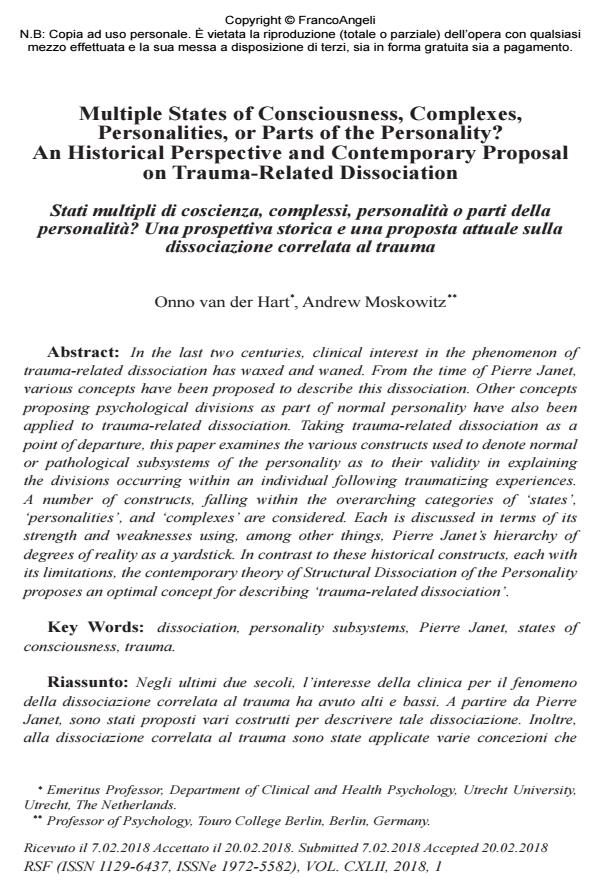Multiple States of Consciousness, Complexes, Personalities, or Parts of the Personality? An Historical Perspective and Contemporary Proposal on Trauma-Related Dissociation
Titolo Rivista RIVISTA SPERIMENTALE DI FRENIATRIA
Autori/Curatori Onno van der Hart, Andrew Moskowitz
Anno di pubblicazione 2018 Fascicolo 2018/1
Lingua Inglese Numero pagine 21 P. 51-71 Dimensione file 1759 KB
DOI 10.3280/RSF2018-001004
Il DOI è il codice a barre della proprietà intellettuale: per saperne di più
clicca qui
Qui sotto puoi vedere in anteprima la prima pagina di questo articolo.
Se questo articolo ti interessa, lo puoi acquistare (e scaricare in formato pdf) seguendo le facili indicazioni per acquistare il download credit. Acquista Download Credits per scaricare questo Articolo in formato PDF

FrancoAngeli è membro della Publishers International Linking Association, Inc (PILA)associazione indipendente e non profit per facilitare (attraverso i servizi tecnologici implementati da CrossRef.org) l’accesso degli studiosi ai contenuti digitali nelle pubblicazioni professionali e scientifiche
In the last two centuries, clinical interest in the phenomenon of trauma-related dissociation has waxed and waned. From the time of Pierre Janet, various concepts have been proposed to describe this dissociation. Other concepts proposing psychological divisions as part of normal personality have also been applied to trauma-related dissociation. Taking trauma-related dissociation as a point of departure, this paper examines the various constructs used to denote normal or pathological subsystems of the personality as to their validity in explaining the divisions occurring within an individual following traumatizing experiences. A number of constructs, falling within the overarching categories of ‘states’, ‘personalities’, and ‘complexes’ are considered. Each is discussed in terms of its strength and weaknesses using, among other things, Pierre Janet’s hierarchy of degrees of reality as a yardstick. In contrast to these historical constructs, each with its limitations, the contemporary theory of Structural Dissociation of the Personality proposes an optimal concept for describing ‘trauma-related dissociation’.
Negli ultimi due secoli, l’interesse della clinica per il fenomeno della dissociazione correlata al trauma ha avuto alti e bassi. A partire da Pierre Janet, sono stati proposti vari costrutti per descrivere tale dissociazione. Inoltre, alla dissociazione correlata al trauma sono state applicate varie concezioni che contemplano la presenza di comparti psichici quali elementi della personalità normale. Questo lavoro, a partire dalla dissociazione correlata al trauma, passa in rassegna i vari costrutti utilizzati per denotare sottosistemi normali o patologici della personalità, evidenziandone la validità nello spiegare le compartimentazioni che si verificano in seguito ad esperienze traumatiche. Vengono considerati diversi di tali costrutti, che ricadono nelle categorie generali di ‘stati’, ‘personalità’, e ‘complessi’. Ciascuno viene esaminato nei suoi punti di forza e debolezza, utilizzando, tra gli altri, il criterio della gerarchia dei livelli di realtà di Janet. In contrapposizione a questi costrutti di importanza storica, ciascuno con le sue limitazioni, l’attuale teoria della Dissociazione Strutturale della Personalità propone un concetto ottimale per descrivere il fenomeno della ‘dissociazione correlata al trauma’.
Parole chiave:Dissociazione, sottosistemi della personalità, Pierre Janet, stati di coscienza, trauma.
Onno van der Hart, Andrew Moskowitz, Multiple States of Consciousness, Complexes, Personalities, or Parts of the Personality? An Historical Perspective and Contemporary Proposal on Trauma-Related Dissociation in "RIVISTA SPERIMENTALE DI FRENIATRIA" 1/2018, pp 51-71, DOI: 10.3280/RSF2018-001004